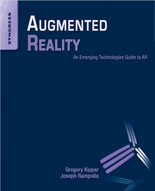Augmented Reality: An Emerging Technologies Guide to AR
 Authors: Greg Kipper and Joseph Rampolla
Authors: Greg Kipper and Joseph Rampolla
Pages: 208
Publisher: Syngress
ISBN: 1597497339
Introduction
Augmented Reality is not the stuff of science fiction any more, and we should all be at least familiar with its current and likely future uses. This book aims to be an easy-to-digest guide on the subject matter.
About the authors
Greg Kipper is a futurist and strategic forecaster in emerging technologies. He has been a keynote speaker at select industry events, a digital forensics instructor, and a trusted advisor in both the government and commercial sectors.
Joseph Rampolla has been a law enforcement officer for 17 years for a suburban police department in the NY/NJ Metropolitan area. In 2003 he was assigned to a regional computer crimes task force in Northern New Jersey. He is a nationally recognized speaker on the topics of cyber crime, augmented reality, virtual worlds, counter-terrorism, cyber-bullying, and undercover IRC investigations.
Inside the book
AR is defined by three characteristics: it combines real and virtual information, is interactive in real time, and operates and is used in a 3D environment.
What Augmented Reality is and what is not (Virtual Reality, QR codes) is addressed in a relatively brief but very informative first chapter. It also explains its components (both hardware and software), platforms, and shares AR history, ending with the present day and concrete examples of AR tools that are currently in use in a variety of business and other sectors.
The second chapter explains how AR works, how it’s created, and how users interact with AR application, and the third one elaborates on its wide range of uses, especially in the world of gaming, sports, entertainment, education, medicine and marketing.
As expected, AR is a perfect fit and offers great value in the sectors of public safety and the military, but there are also a number of ways in which it can be dangerously misused. The fourth chapter addresses some of the legal issues that might and probably will arise with the use of AR (especially regarding privacy).
The next one introduces individuals (researchers) that are currently working and innovating in the AR field, the companies specializing in it, and offers lists of links to AR tools and blogs – great for delving deeper into the subject.
Finally, there is a chapter on the societal and technical trends that work in favor of AR development and use in the short run, and on expected breakthroughs in genetics, nanotechnology and robotics that will shape AR in the decades to come.
Final thoughts
If you are not familiar with the concept of AR, this book will be an eye-opener. It is a quick and fascinating read, and the authors don’t get bogged down in unnecessary details.
They do repeat themselves on occasion, but all in all, this book is a perfect starting point for discovering the topic and whether you are interested in finding our more about it.
